Candidates Day Nine: The Turns Have Tabled
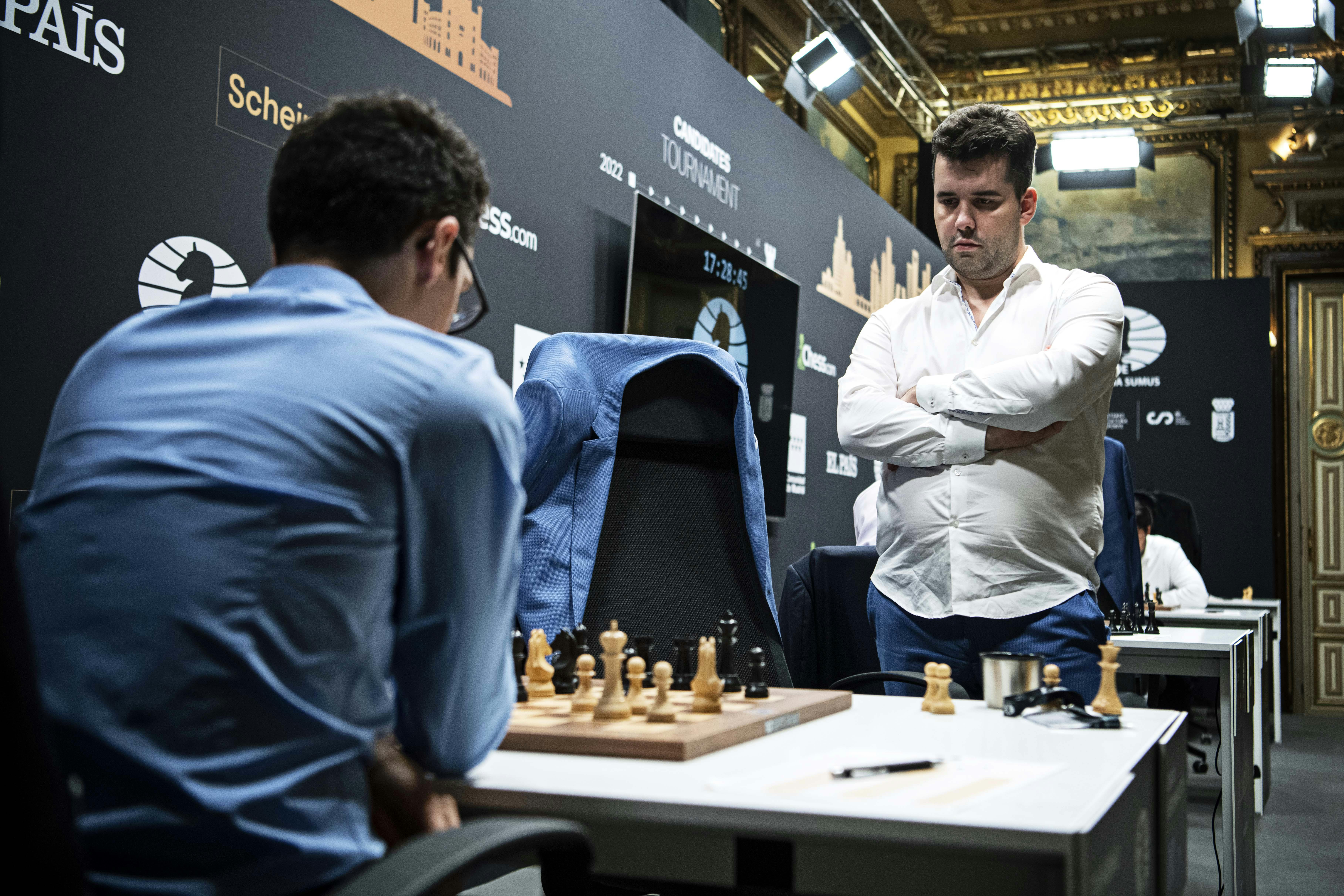
Credits: FIDE/Stev Bonhage
The ninth round of the Candidates Tournament in Madrid has concluded. With three wins and one draw, Nepomniachtchi solidified his lead, while Firouzja, Radjabov and Ding scored their first wins, and the era of the Berlin Defense as a drawing weapon seems to be coming to an end…
Daily, Lichess is providing a broadcast of the games played in real-time. We also have a selection of annotated games by GM Jon Speelman and video recaps by WGM-elect Jesse February.
Game One: Firouzja v Rapport: 1 – 0
The game between Alireza Firouzja and Richard Rapport in Round 2 was probably not the double edged sharp game full of fireworks we may have expected; however, their Round 9 game was more than sufficient compensation! With the Berlin defense on the board, one could expect a dry quick draw (even if it more often than not wasn’t the case in this Candidates tournament). Well, that doesn’t sound much like Firouzja or Rapport… By move 10, the two players are out of their preparation and reach a position that was played in top level only once, in a game between Karjakin and Vidit in World Blitz Championship 2019. With 11. Nc4 played, Black could go for 11… Bc7 like the original game or continue with 11…Bg4 12. Qe1 Bc7. Indeed, Rapport played 11… Bg4 but at 12. Qe1, he replied with …Bc5, preparing the more ambitious albeit riskier a5-a4-b5 plan, while Firouzja prepared and played f4. With this position reached, Firouzja decided to sacrifice yet another pawn, by playing 13. Be3!?. He may be two pawns down, but he had quite some compensation for it - Black king is still in the center and his pieces not very well coordinated, while Firouzja has much better piece coordination and is ready to grasp the initiative! And, this is what happened in the next moves, with Rapport having to find the best moves and Firouzja improving his piece placement with tempi and being ready to punish the slightest mistake. And while one could argue this position reached at move 26 is at least not objectively better for white (especially if you check the evaluation), it’s by far easier to play - which is what mattered in the game. 26… Bc4 may seem natural but it allowed 27. Rf5! Further disorganising Rapport’s pieces and giving Firouzja an overwhelming attack - totally suitable to his style. In an increasingly hopeless position, Rapport tried to create counterplay with 31… h5, a queens trade which was of course not accepted and h4. These attempts were nevertheless in vain, and Black was forced to resign at move 41 being a piece down with no counterplay or defensive resources. Firouzja convincingly got his first win in the Candidates, reminding us why he is one of the most promising young players, despite not having his best performance in this tournament.
https://lichess.org/study/embed/E5069VUJ/kfHwi0ta
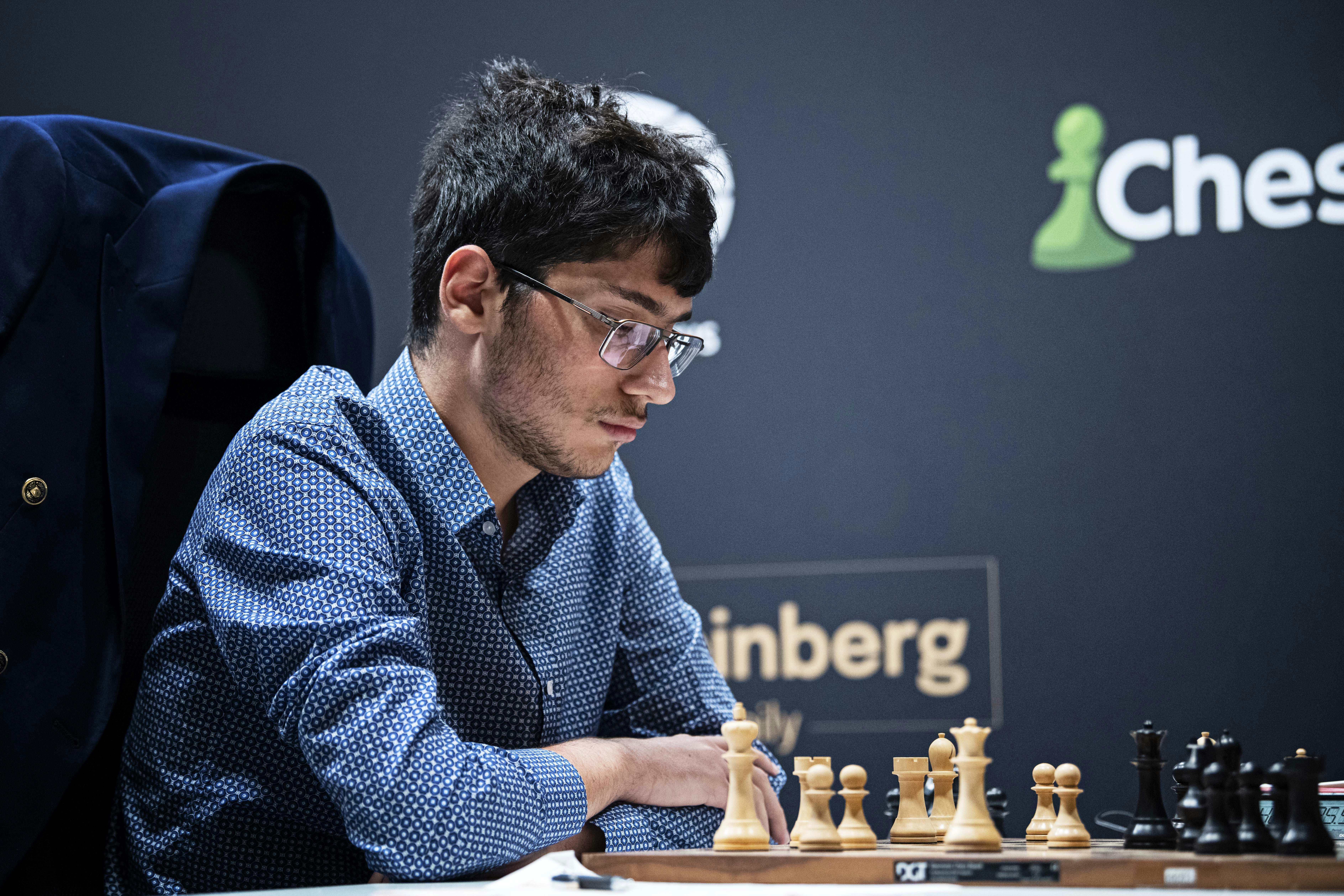
Credits: FIDE/Stev Bonhage
Game Two: Radjabov v Nakamura: 1 – 0
The match between Teimour Radjabov and Hikaru Nakamura in Candidates 2022 could also be described as a Berlin battle; In round 2, Radjabov played the Berlin defense against Nakamura - and lost; today was the time for the roles to be reversed… Nakamura, at move 6 decided to deviate from the 6… d6 mainline, and play 6… d5 7. Nbd2 dxe4 8. dxe4 a5; while it’s not the most common, there are still a few games between top layers - including Vidit - in this position. One of the decisive moments of this game, even if probably not apparent at first sight, was 13… Bg4; by playing this Nakamura sacrificed his a-pawn for some compensation on the kingside; the problem was that Radjabov could defend this, but in return got a pawn majority to march on the queenside, and an a-pawn that was later on proven critical. Of course the position was nowhere near losing for Nakamura, but Radjabov would have an easier play and an edge. Radjabov built on his advantage while Hikaru struggled to find an efficient defense; with the position getting increasingly difficult to handle and him under pressure, disaster was almost inevitable to happen - and indeed did at move 28. After 28… cxb4 29. cxb4 Rf6 30. b5, Radjabov gets a strong knight on c6, an extremely dangerous outside passed pawn on the a-file supported by an also dangerous b-pawn, and active rooks (the rook on e2 can help at any moment), while Nakamura is left with a knight on the other side of the board, a passive rook on a8 and no realistic counterplay or clear defensive plan. Radjabov went on converting this position, scoring his first win in the tournament and shattering any slight hopes created for Hikaru to potentially win candidates, after his Round 8 win.
https://lichess.org/study/embed/E5069VUJ/5qxgeSgO
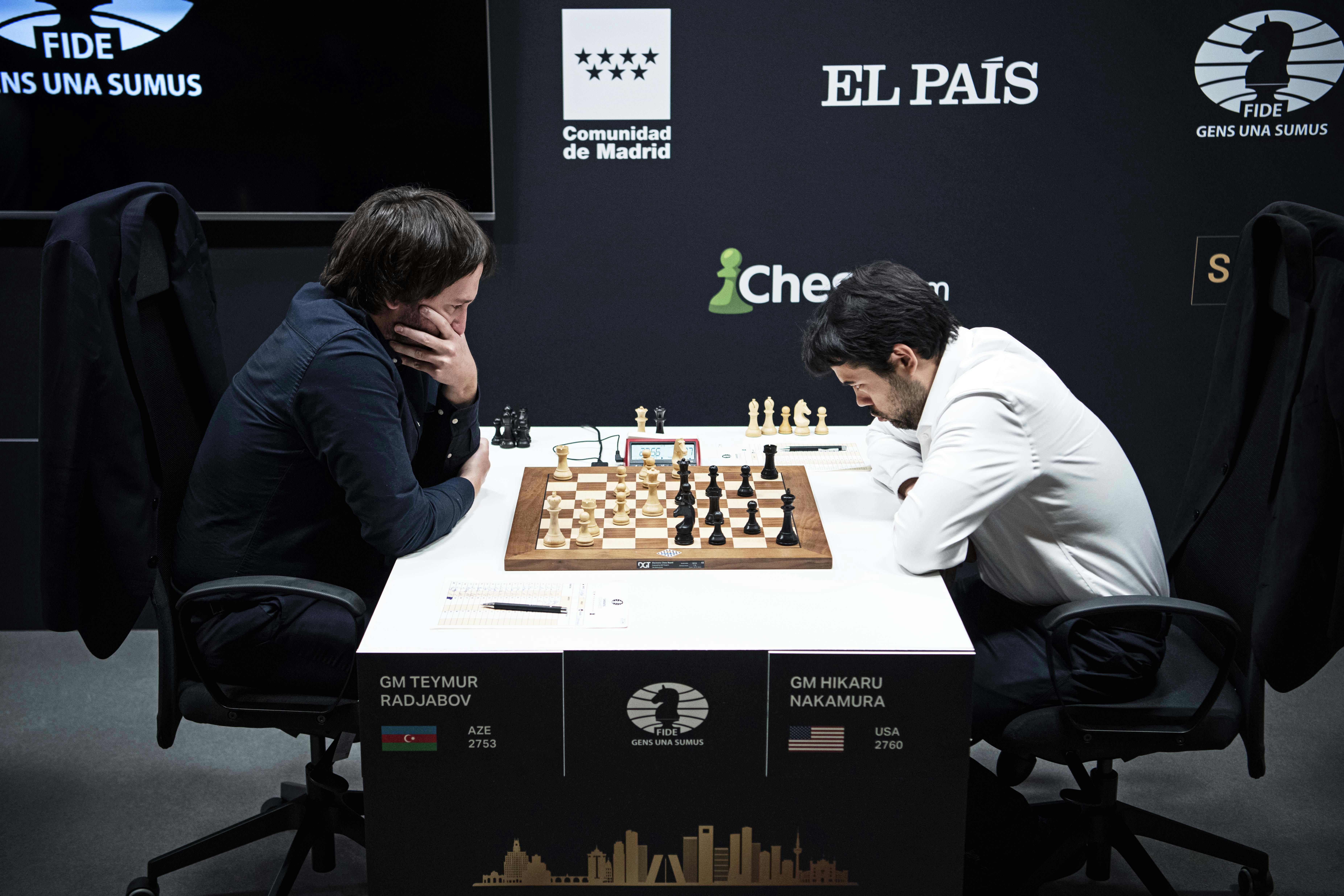
Credits: FIDE/Stev Bonhage
Game Three: Caruana v Nepomniachtchi : ½ – ½
Fabiano Caruana and Ian Nepomniachtchi, the main contenders after the first half of the tournament, for the first place - and the right to face Magnus Carlsen in the World Championship Match - faced each other again in Round 9 of the Candidates. With Caruana being 1 point behind from Nepomniachtchi, a decisive result from either player could significantly affect the outcome of the tournament. The two players stayed in known territory sticking to one of Petrov’s Defense mainlines - or that’s what it looked like until move 10. Caruana had apparently prepared a novelty for this position, and within seconds played 11. Nh4, followed by 12. Qc2. This definitely took Nepomniachtchi out of preparation; by move 17 he had spent 55 minutes and having difficulty finding the best moves, while Caruana had spent slightly less than 6. Caruana developed an edge - mainly due to better piece coordination. This edge, however, was proved quite fragile; after the natural-looking 24. Bxf5 and the resulting exchanges, any difficulties black was facing in his position were resolved and white’s advantage evaporated. Caruana, probably shocked, given the importance of a win in this game, spent 13 minutes debating with himself between 28. Re4 and 28. Re2, or potentially looking for a hidden way to maintain his advantage; eventually he opted for Re4, being left with 5 minutes until move 40. The game ended in a draw by repetition at move 40. This result solidifies Nepomniachtchi’s lead and puts even more pressure on Caruana if he wants to stay in the race for first place, but with 5 rounds left, and a few players having nothing to lose while 2nd place still being in reach, the Candidates tournament may still have some surprises in store…
https://lichess.org/study/embed/E5069VUJ/n4hx3LQ1
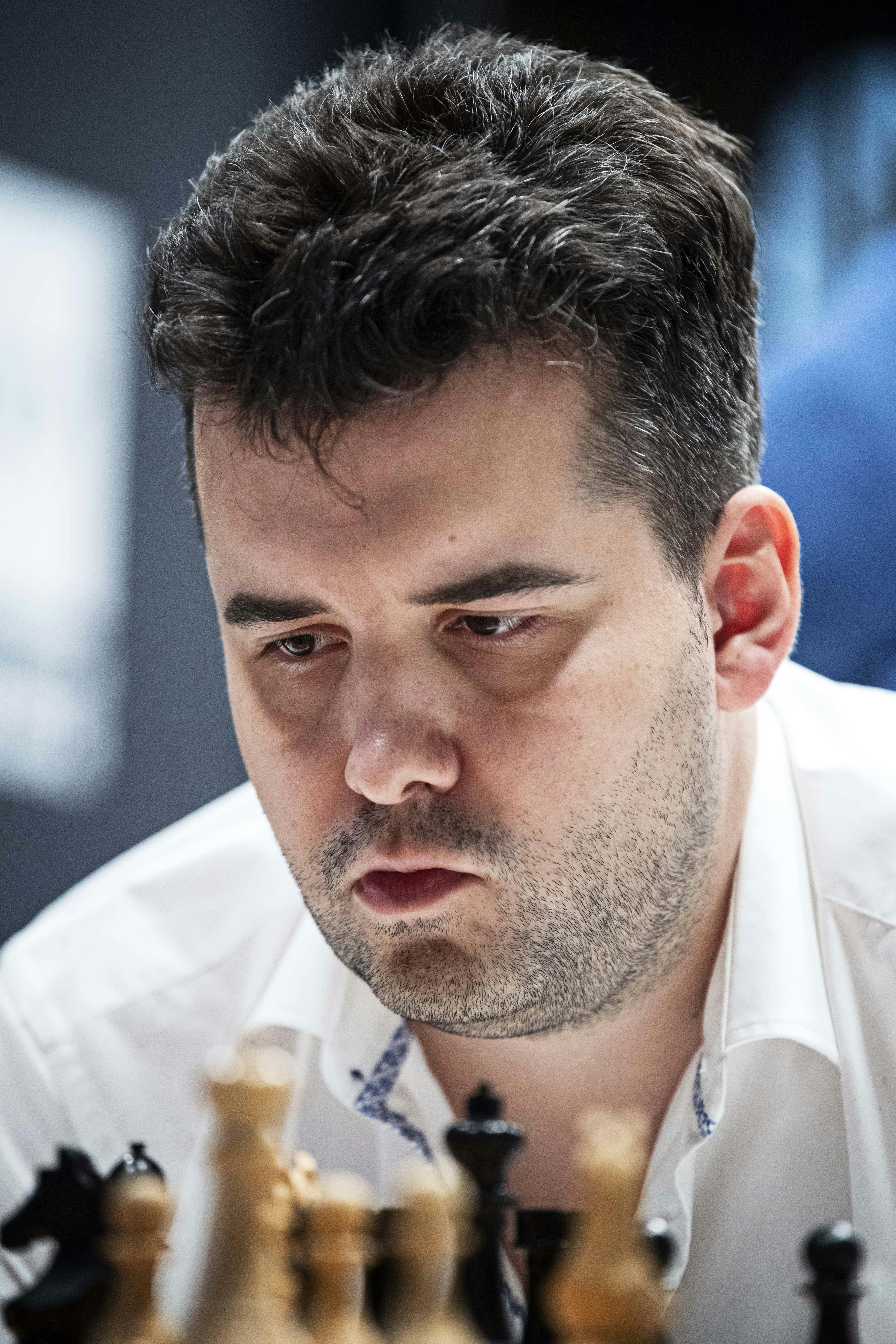
Credits: FIDE/Stev Bonhage
Game Four: Ding v Duda: 1 – 0
Ding Liren, despite having a rough start in the Candidates tournament - including his round 1 loss and his missed win vs Rapport, proved his class once more, convincingly outplaying Jan-Krzysztof Duda in the endgame. With 1. c4, played, the queens were exchanged already by move 18; but no, a quick draw was not what Ding had in mind. The two players got into an endgame where white seemed to constantly have a slight edge and better control of the position - out of which he wanted to squeeze his first win in the Candidates. Indeed, after the natural 28… Rd8, Ding is ready to prepare getting an outside passed pawn on h-file with 29. Nc6 - 30. Nxa5 - 28… Bb3 29. Rc4 Rb8 would had been a better option with black being quite comfortable. Ding kept making progress with Duda spending a lot of time to figure out how to proceed; after 37. Rc1! Bf3+ 38 Kg1 Ra3, white has a very strong idea, and black would have only 1 minute to figure out how to deal with the next two moves. 39. Nc4 was played, gaining a tempo and wanting to bring the knight on e5 and the rook on 7th rank; the only defense would have been 40… Bh4! 41 Rc7 g5! 42 fxg5 Nxe4 with white still having an advantage but black having realistic chances of holding the position. Instead, under pressure, Duda played 40… Bxe4 allowing Ding to execute his plan. 46. f3! was a very interesting idea by Ding! The bishop cannot leave the h1-a8 diagonal due to a7-Rc8+-a8=Q incoming, eliminating the knight which was one of the last defensive resources of black would only favor white - even at the cost of a pawn - while 46… Bd5 would be met by 47. Bc5 Bxc4 48. Rxc4! and black’s knight is in trouble - after Ne2 black would have to sacrifice it due to the incoming Rc7+ with the pawn being promoted in a few moves. In sight of all these, Duda took on f3, and Ding went on to convert this position into his first win!
https://lichess.org/study/embed/E5069VUJ/gLSS2Dxc
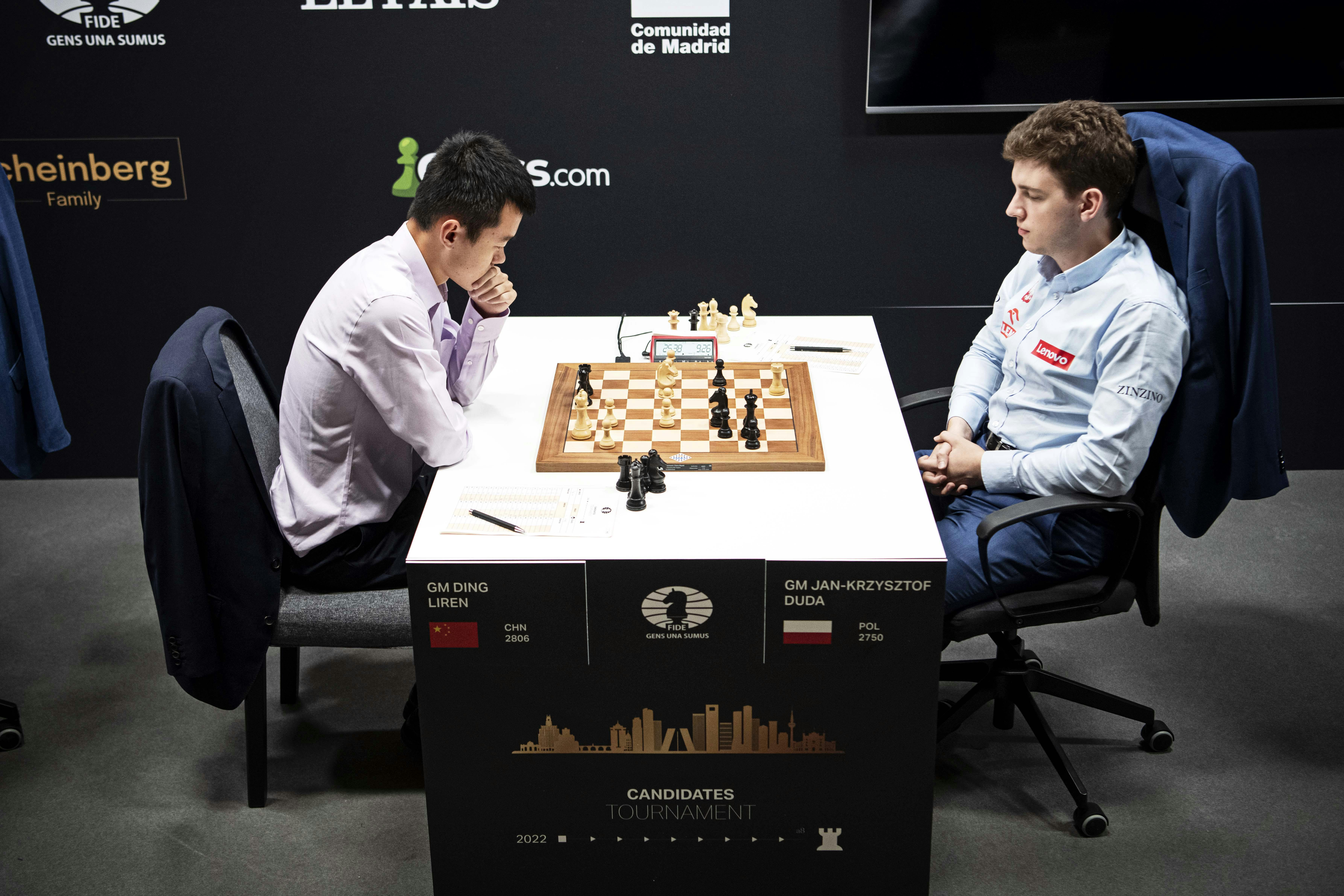
Credits: FIDE/Stev Bonhage